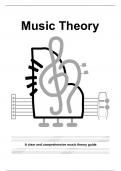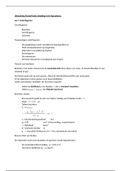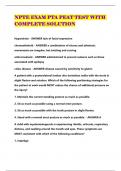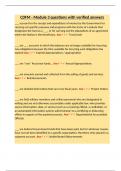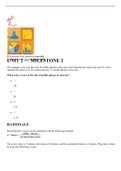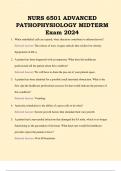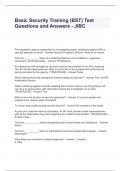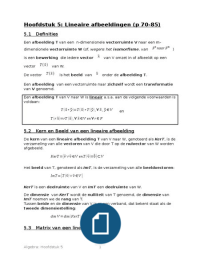History of Psychology Lecture
Psyc 101 – Eva Zysk
- Statistics in psychological research is w ay to record, analyze, and draw conclusions from the studies we
conduct
- Two types:
Descriptive
o Numbers that are used to summarize and describe a set of data collected
o Tells you only about the sample you collected data from
o Can use data to create frequency distribution, frequency polygon, histogram
o Bell Curve normal distribution & standard deviations.
o Central Tendency:
- Mean: Average of set of data (numbers)
- Median: The middle number in a set of data
- Mode: the number in a set of data that occurs most often (possible to have no
mode)
- Range: distance between the highest and lowest scores in a set of data
- Standard Deviation: the variance of scores around the mean (how far, on
average, each score is from the mean, high standard deviation (more spread
out))
Inferential
o The purpose is to discover whether the finding can be applied to the larger population
from which sample data was collected.
o Did we get our results because of what we did, or because of chance?
o How can you answer that question
- P value can answer the question
- P-value calculation tells us the likelihood of whether our statistics on data
occurred by chance
- P-value has to be = or <0.5, equal to or less than a 5% chance we got our data
from our study chance.
What can the scientific method tell us? Lecture 1:
Forer Effect
- Also known as the Barnam effect, in 1948, a psychologist Bertram Forer gave a personality test to his
students
- They gave “a unique personality analysis that was based on the tests results”
Average accuracy rating was 4.26/5
Forer had assembled these from a newsstand astrology book; was the same for all students
- Self-serving bias
Critical Thinking
- Psychologists collect evidence about mental processes and behaviours
- Evidence can come about from experiments, naturalistic observation studies, case studies, and
psychological tests
- Psychologists make claims and conclusions
- Critical thinking often involves:
Identifying and analysing arguments and claims
, Discovering and overcoming prejudices and biases
Considering, comprehending and valuing other interpretations and perspectives such as
objections to your beliefs
Evaluating evidence
Distinguishing facts from assumptions
Ability to underpin an argument with solid evidence
Reviewing and developing your argument through a continuous cycle of reflection and
adaptation
Formulating a personal judgment based on all the above
Key to Critical thinking: THINK RED
o Recognize Assumptions
o Evaluate Arguments
o Draw Conclusions
- Curiosity, Skepticism, Humility
Future of Jobs and Skills
- Complex problem solving
- Critical thinking
- Creativity
- People management
- Coordinating with others
- Emotional intelligence
- Judgment and decision making
- Service orientation
Toolbox for Sceptics
Some key questions to ask about any evidence:
- Who, or what, is the source?
Does the evidence come from someone with an international reputation for good work or did you
hear it at the hair salon?
- Where was the information published?
Was it in a scientific journal which has other scientists looking at the work before it is published
or was it in VOGUE magazine? The claims must be verified by a review team
- What is the evidence?
Is it plausible and does it make sense?
- Is there an alternate explanation?
The evidence is presented and then interpreted for us. Can we interpret it differently?
- What is the possible bias? What were the possible motives of the people who published it?
Is there any influence on the presentation of the evidence? Should we believe the sellers of a beer
company that they have the best beer?
What is Psychology?
- Etymology of “psychology”
Psyche / psyche breath, spirit, soul
Logia study of
- The study of mental processes and behaviour
- Mostly common sense: we are people, this we understand people.
- The scientific mind must be SKEPTICIAL not cynical, and it has to be OPEN but not gullible
, Research Methods: Lecture 2
Thinking
- Confirmation bias: the tendency to search for, interpret, favour, and recall information in a way that
confirms or supports one's prior beliefs or values
- In psychology we almost never have evidence that guarantees conclusions
But research evidence can make conclusions more or less likely.
Psychology as Science
- Scientific researchers have two main objectives:
Theory building (induction): suggesting explanations for the way people behave)
Theory testing (deduction): collecting evidence that may show a theory to be a good explanation
or a bad explanation for the way people behave.
Theory Building
- Not only critical thinking
- Formulate explanations as to how things work
o Integrated set of principles
o Organized observations
o Making testable predictions
- Good theory is composed by:
Needs to be falsifiable and needs to be parsimonious (simplest explanation of an event or
observation)
Occom’s razor: rationality of simplest explanation
- Parsimony
Theory A: Aggressive behaviour on TV aggressive behaviour by children
Theory B: Aggressive behaviour on TV Children develop aggressive identity Aggressive
behaviour by children.
- Hypothesis: a falsifiable prediction
If you are paid for doing something you enjoy, you will like it less
If you perform a behaviour that is contrary to your attitude, your attitude will change.
Require a testable opportunity, independent and dependent variable.
Must use operant definitions to allow others to repeat experiments and hypothesis
o Theories (explain) Hypotheses (predict) Research (tests). (CAN WORK ANY
WAY)
- Bystander Effect
Observation Theory: Inductive Reasoning
Theory Observation: Deductive Reasoning
- Yawning Theory
Yawning not only about oxygen or being tired
People tend to mimic behaviour of conversation partner (Condon & Ogston, 1967)
Social bonding
Common form of echophenomena the automatic imitation of another’s words or actions
Hypothesis: The more times I yawn, the more times you yawn (inductive reasoning)
Yawning and Social Bonding
- Research showing yawning and social bonding are related
- More frequent yawning with closer others (Norscia & Pallagi, 2011)

